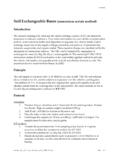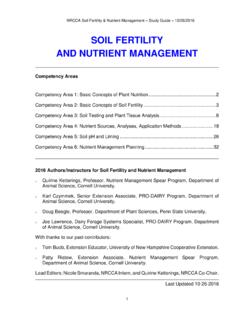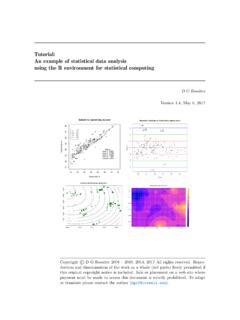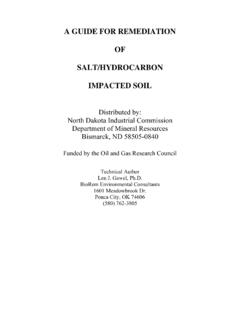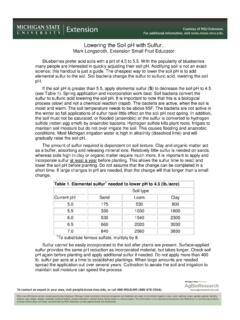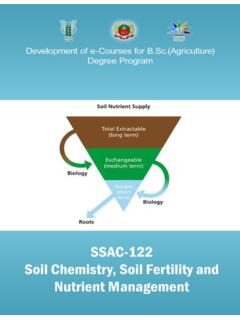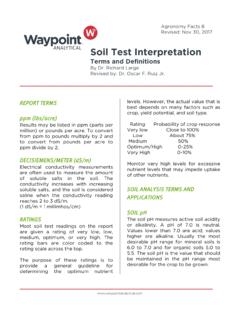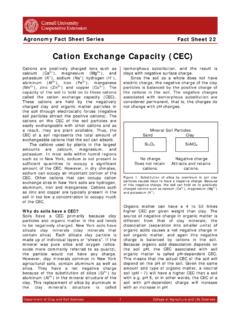Search results with tag "Cation exchange capacity"
Soil Exchangeable Bases (ammonium acetate method) - AU
mit.biology.au.dkH. BRIX Soil Exchangeable Bases (ammonium acetate method). Introduction The amount exchangeable bases and the cation exchange capacity (CEC) are important
Liming to Improve Soil quality - USDA
www.nrcs.usda.govgiven amount. As cation exchange capacity increases (higher clay and organic matter), the amount of liming material needed to change soil pH also increases. Soils with a low cation exchange capacity may only require 1 ton of agricultural limestone to change a pH from 4.5 to 6.5; whereas, a soil with a higher CEC may require 2 tons
Soil Texture - Cornell University
nmsp.cals.cornell.eduCation exchange capacity (CEC) pH buffering capacity Soil tilth ... 40% silt and 20% clay would be classified as a loam. Figure 1: A soil textural triangle is used to determine soil ... regulation or standard, or the achievement of particular discharge levels from agricultural land. For …
Collecting Soil Samples for Testing
www.extension.purdue.education exchange capacity. 3 | Collecting Soil Samples for Testing . CONSUMER HORTICULTURE | HO-71-W Some gardening books advise a general lime application to garden plants. Yet most Indiana gardens have a soil pH that is already near neutral, if not slightly alkaline. So, applying lime will not help (and may hurt) nutrient availability
SOIL FERTILITY AND NUTRIENT MANAGEMENT
nmsp.cals.cornell.eduOct 26, 2016 · Cation exchange capacity (CEC) is a measure of the amount of cations (positively charged ions) that can be held by the soil. As the clay content, organic matter content and pH increase, the CEC will also increase. As CEC increases, so does the ability of the soil to hold nutrients. Since much of the plant
An example of statistical data analysis using the R ...
www.css.cornell.edu2.Cation exchange capacity (code CEC), cmol+ (kg soil)-1 3.Organic carbon (code OC), volume % of the ne earth. These three variables are related; in particular we know from theory and many detailed studies that the CEC of a soil depends on reactive sites, either on clay colloids or on organic complexes such as humus, where cations (such as K+ and
A GUIDE FOR REMEDIATION 20060502 FullSize
www.dmr.nd.govDispersion will occur when more than 15% of the cation exchange capacity sites on clays are occupied by sodium ions and when the total EC in the soil solution is low. The potential dispersion of a soil can be determined by the exchangeable sodium percentage (ESP). Soil dispersion results in: • Loss of soil structure • Loss of pore structure
Lowering the Soil pH with Sulfur. Mark Longstroth ...
www.canr.msu.eduThe CEC or Cation Exchange Capacity can be used to estimate soil texture General range of CEC for different soil texture groups: Soil Type CEC Loamy sand: < 5 meq/100 g Sandy loam: 6-8 meq/100 g Loam: 9-12 meq/100 g Clay loam: 12-17 meg/100 g For example, if your soil sample had a soil pH of 6.5 and a CEC of 12-meq/100 g, this suggests a loam soil.
Soil Chemistry, Soil Fertility & Nutrient Management
agrimoon.comSoil pH and Percent Base Saturation 7-9 4. Soil as a source of plant nutrients - Essential and beneficial elements, criteria of essentiality ... available to plants is known as cation exchange capacity (CEC). A soil's CEC depends on the amount …
Soil Test Interpretation - Waypoint Analytical
www.waypointanalytical.comCATION EXCHANGE CAPACITY (CEC) CEC measures the soil’s ability to hold nutrients such as calcium, magnesium, and potassium, as well as other positively charged ions such as sodium and hydrogen. The CEC of a soil is dependent upon the amounts and types of clay minerals and organic matter present. The common expression for CEC is in terms of
What Can We Learn From CEC and Base Saturation?
www.agvise.comWhat Is Cation Exchange Capacity? In fundamental terms, this permanent soil property is a measure of the relative number of negative electrical
Cation Exchange Capacity (CEC) - Cornell University
nmsp.cals.cornell.edugreater water holding capacity than low CEC (sandy) soils. o Low CEC soils are more likely to develop potassium and magnesium (and other cation) deficiencies, while high CEC soils are less susceptible to leaching losses of these cations. So, for sandy soils, a large one-time addition of cations e.g. potassium can lead
Similar queries
Soil Exchangeable Bases ammonium acetate method, Cation Exchange Capacity, Liming to Improve Soil quality, USDA, Soil Texture, Regulation, Collecting Soil Samples for Testing, SOIL FERTILITY AND NUTRIENT MANAGEMENT, A GUIDE FOR REMEDIATION, Soil Chemistry, Soil Fertility & Nutrient Management, Base Saturation, From CEC and Base Saturation, Capacity, Large
